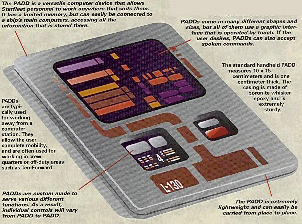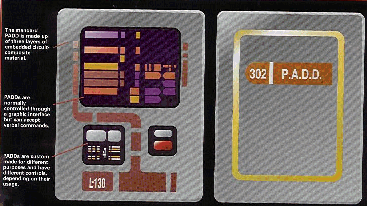
PADDs
Among the complex computer systems aboard any starship, the handiest and most
practical facet for most crew members is the appropriately named PADD.
The development and evolution of the Personal Access and Display Device
has been one of the greatest spurs of crew members' ease of work and
functionality in their shipboard tasks. It has freed Federation personnel
from mounted computer interfaces and terminals, and made it easier for them to
communicate and transfer information.
The PADD is extremely powerful and, if properly configured for conn
interface, it could even be used to fly the entire starship from any location
from crew quarters to a corridor - if memory and display units were no problem.
This ability reflects the Federation design goal of making handheld devices able
to access any file or program in line with the user's security clearance. (See
Microsoft Windows CE 2.x devices)
Construction
The standard PADD design features a basic three-layered construction of embedded
circuit-composite materials that are no more than 1 cm thick in total. A casing
of boronite whicker epoxy carries the primary electronics bonded on, including
the multi-layered screen; it provides protection even when dropped from a height
of upto 35 meters.
Components
 The PADD includes three
replaceable elements:
The PADD includes three
replaceable elements:
The fully-charged sarium cell provides 16 hours of operation and is normally
induction recharged when off-duty. When near exhaustion, it automatically flags
the main computer to transfer its task to a working unit.
Memory capacity of the isolinear chip is 4.3 kiloquads. Like the tricorder, the
PADD can dump its memory to a main computer in less than a second.(We're talking
serious file transfer rates here)
Finally, the STA allows a data link between the PADD and the ship's computer
over the same range as a communicator. This means that away teams can use PADDs
which can also provide a transporter lock-on signal.
PADDs can also share computing functions and data transmissions with any other
Starfleet device employing comm protocols (read IR transmissions) as used for
STA devices. As with the communicator, such transmissions are secured by
encryption. (Not unlike PGP 5.0i)
 Interface
Interface
A user interface is provided by both built-in electro-sensitive areas of the
casing and touch areas on the screen.
These are operated like any other multi-layer panel found in modern starships.
The interface areas are designed for specific data manipulation and storage
functions, and can be used to personalize the default setup and offer a
corresponding security restriction to a single user.
Custom models can be fabricated aboard a Galaxy-Class starship or any other
replication facility equipped with custom isolinear circuit programming
capability.
The earliest models of PADDs measured a standard 10 x 15 centimeters and
contained a display area 4.25 times larger than that of a tricorder, with
generic control interface areas marked in brown. Later models have varied in
shape and size, with some offering larger screens and even more designed control
surfaces. The smallest PADDs are little more than palm-sized; the largest are
the size of a large tray. In all models, the screens allow the user to control
the PADD through a graphical interface.



